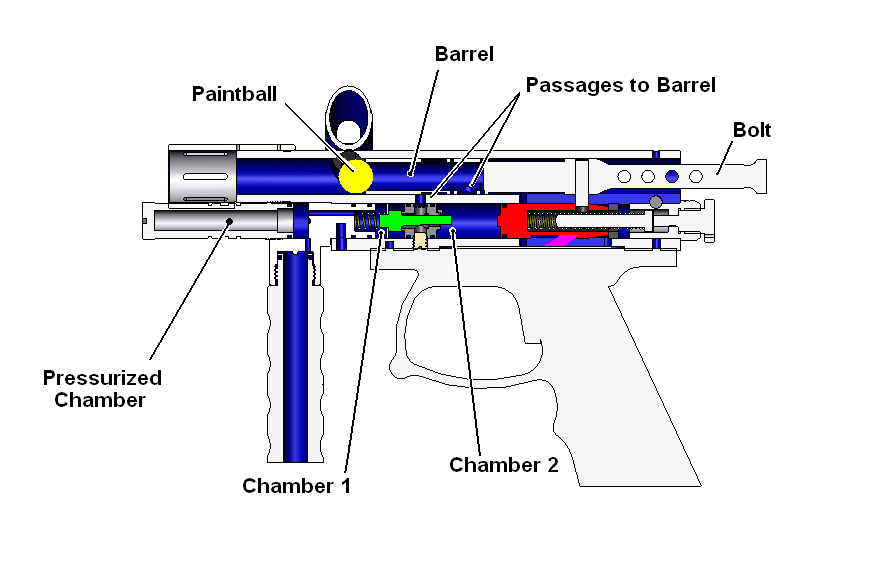How Does A Paintball Regulator Work
Adapter: Paintball tank threading is the same in the UK, USA, Europe, etc. The adapter is simple enough – female threads that attached to the CO2 tank, male threads for the regulator to attached to, and an adjustable assembly that presses the pin on the paintball tank to enable gas to flow.
Co2 Paintball Regulator
I have force-carbed nine 5-gal kegs so far, and I just emptied my only second 20 oz paintball tank. I normally maintain pressure at 8 to 12 psi, depending on the beer style. I think it's a great setup, and it saves room in the fridge compared to the larger 5 lb tanks. I have a sleeve for the tank with a carabiner clip attached so it can hang from the fridge shelf above the kegs.Based on my kegging experience, you may have had a gas leak if you could only carb one keg out of one 20 oz bottle.I bought a second 20 oz tank right away, because I was skeptical and wasn't sure how long one would last. I was pleasantly surprised that I could carb and serve 9 kegs out of 2 tanks over the last year.I still bottle occasionally, but it's damn fine to be able to pull your own beer from a tap!Cheers! Nine kegs force carbed and served with 20 oz of CO2 is pretty impressive, IMO.
I average about 2/3 lb per keg force carbing, serving, purging, seltzer, etc, etc, etc. (a 20 lb tank lasts about 30 kegs on my system). And I'm pretty obsessive about leaks. I guess it's time for another inspection.I'm not sure I would encourage people to use 20 oz tanks, though, purely due to the cost. A 15 oz SodaStream CO2 swap, for example, costs around $15. That's $1 per oz(!!!) Granted, this is proprietary and, no doubt, pricier than a 20 oz paintball tank, but the 20 oz tank is likely a far cry pricier per lb than a 20 lb or even 5 lb tank. ($25 and $20, respectively, in my neck of the woods).
Given the more-or-less permanent nature of a kegerator in a typical home setup, the perceived convenience of a skinny tank is not worth the added cost, IMO (obviously, YMMV). My 20 lb tank (about the size of a corny keg) is in a closet adjacent to the bar - it consumes zero space in the fridge. Indeed, since there are no line length considerations, you could install the CO2 in the basement, the garage, or even the attic, if that's more convenient (at about 2 1/2 years between refills for my 20 lb tank, the attic would not be out of the question).All that having been said, it's nice to know there are options to suit virtually every need.
Nine kegs force carbed and served with 20 oz of CO2 is pretty impressive, IMO. I average about 2/3 lb per keg force carbing, serving, purging, seltzer, etc, etc, etc.

Low Pressure Paintball Regulator
(a 20 lb tank lasts about 30 kegs on my system). And I'm pretty obsessive about leaks. I guess it's time for another inspection.I'm not sure I would encourage people to use 20 oz tanks, though, purely due to the cost. A 15 oz SodaStream CO2 swap, for example, costs around $15.
How Does An Air Regulator Work
That's $1 per oz(!!!) Granted, this is proprietary and, no doubt, pricier than a 20 oz paintball tank, but the 20 oz tank is likely a far cry pricier per lb than a 20 lb or even 5 lb tank. ($25 and $20, respectively, in my neck of the woods). Given the more-or-less permanent nature of a kegerator in a typical home setup, the perceived convenience of a skinny tank is not worth the added cost, IMO (obviously, YMMV). My 20 lb tank (about the size of a corny keg) is in a closet adjacent to the bar - it consumes zero space in the fridge. Indeed, since there are no line length considerations, you could install the CO2 in the basement, the garage, or even the attic, if that's more convenient (at about 2 1/2 years between refills for my 20 lb tank, the attic would not be out of the question).All that having been said, it's nice to know there are options to suit virtually every need.